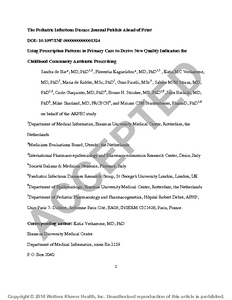de Bie, S;
Kaguelidou, F;
Verhamme, KM;
de Ridder, M;
Picelli, G;
Straus, SM;
Giaquinto, C;
Stricker, BH;
Bielicki, J;
Sharland, M;
et al.
de Bie, S; Kaguelidou, F; Verhamme, KM; de Ridder, M; Picelli, G; Straus, SM; Giaquinto, C; Stricker, BH; Bielicki, J; Sharland, M; Sturkenboom, MC; ARPEC study
(2016)
Using Prescription Patterns in Primary Care to Derive New Quality Indicators for Childhood Community Antibiotic Prescribing.
The Pediatric Infectious Disease Journal(R), 35 (12).
pp. 1317-1323.
ISSN 0891-3668
https://doi.org/10.1097/INF.0000000000001324
SGUL Authors: Sharland, Michael Roy
![[img]](https://openaccess.sgul.ac.uk/108327/1.hassmallThumbnailVersion/00006454-900000000-97274.pdf)  Preview |
|
PDF
Accepted Version
Available under License ["licenses_description_publisher" not defined].
Download (1MB)
| Preview
|
Abstract
BACKGROUND: To describe patterns of antibiotic outpatient use in three European countries, including two new pediatric-specific quality indicators (QIs). METHODS: A cohort study was conducted, 2001-2010, using electronic primary care records of 2,196,312 children up to 14 (Pedianet, Italy) or 18 years (THIN, UK; IPCI, the Netherlands) contributing 12,079,620 person-years. Prevalence rates of antibiotic prescribing per year were calculated and antibiotics accounting (drug utilization) for 90% of all antibiotic prescriptions were identified (DU90% method). The ratio between users of broad to narrow-spectrum penicillins, cephalosporins and macrolides (B/N ratio) and two pediatric-specific quality indicators (QIs): the proportion of amoxicillin users (amoxicillin index, AI) and the ratio between users of amoxicillin to broad-spectrum penicillins, cephalosporins and macrolides (A/B ratio) were determined. RESULTS: The overall annual prevalence of antibiotic prescriptions was 18.0% in the Netherlands, 36.2% in the UK and 52.0% in Italy. Use was maximal in the first years of life. The number of antibiotics accounting for the DU90% was comparable. The B/N ratio varied widely from 0.3 to 74.7. The AI was highest in the Netherlands and the UK (50-60%), lowest in Italy (30%) and worsened over time in the UK and Italy. The A/B ratio in 2010 was 0.3 in Italy, 1.7 in the Netherlands and 5.4 in the UK. CONCLUSIONS: The patterns of antibiotic prescribing varied highly with age and country. The pediatric-specific QIs combined with the total prevalence rate of use provide a clear picture of the trends of community childhood antibiotic prescribing, allowing monitoring of the impact of policy interventions.
Statistics
Item downloaded times since 27 Oct 2016.
Actions (login required)
 |
Edit Item |



